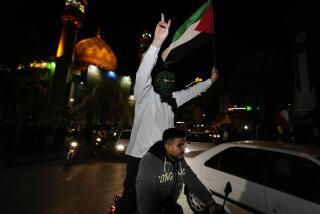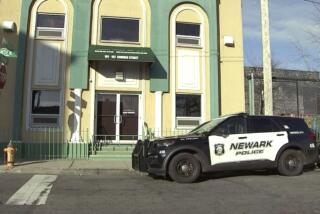A Suspected Operative of Al Qaeda Is Held in Iraq
A man believed to be an Al Qaeda operative, found with 11 surface-to-air missiles, has been arrested in Iraq by U.S. troops and has acknowledged that he had been training with Ansar al Islam fighters to use the weapons against American forces, a senior U.S. official said Friday.
The arrest marks the first time the U.S.-led coalition has apprehended someone believed to be a member of Osama bin Laden’s Al Qaeda terrorist network who is operating in Iraq.
The unnamed suspect was captured during an Aug. 20 raid in Ramadi, west of Baghdad, along with two other unnamed men, said the official, who spoke on condition of anonymity. At least one of the other men was believed to be a member of the extremist group Ansar al Islam, the official said.
Intelligence officials said they found the suspected Al Qaeda member’s account, given during interrogation, “credible.”
They declined to characterize how senior the alleged operative was or whether he had directed attacks on American troops or elsewhere before his capture.
A senior FBI official said that he was unaware of the arrests but that the capture of self-described Al Qaeda terrorists with such weapons is cause for significant concern.
“Lord yes, that concerns us. That type of equipment has the capability to do extensive damage,” said the senior official, who spoke on condition of anonymity. “If they want to bring down an aircraft, or fire that into a building or a compound or anything like that, you are going to do significant damage in terms of injury and death.”
The FBI official said it appeared to be the first time anyone believed to be an Al Qaeda member had been caught while in possession of surface-to-air missiles. Last year, the official noted, suspected Al Qaeda members fired two such missiles at an Israeli commercial jet as it was leaving an airport in Mombasa, Kenya, just missing the plane. The official said that one firing device was recovered but that no suspects have been apprehended in that case.
“Everyone thinks terrorists would use those [missiles] to fire at planes, which are hard to hit,” the official said. “But there are any number of targets they could fire on that are stationary and much easier to hit, and they would cause mass casualties too.”
Before the Iraq war, the Bush administration had contended that Iraq had links to Al Qaeda through Ansar al Islam, a claim used to bolster its allegation that the country was involved in international terrorism. But no hard evidence of such a link has been uncovered. The arrest of the suspected Al Qaeda member does not resolve whether Al Qaeda was operating in Iraq before the war or was drawn by the conflict.
“It would be amazing if Al Qaeda did not have operations in Iraq,” said Anthony H. Cordesman, a former senior Pentagon official who is now a military analyst on Iraq at the Washington-based Center for Strategic and International Studies. “What surprises me is the number of [surface-to-air missiles]. When you get that many missiles in-country, you’ve got a problem.”
U.S. officials in Iraq recently told reporters that Ansar al Islam, expelled from its northern Iraqi bases by American forces during the war, had regrouped and was operating in Baghdad and elsewhere.
The organization recently intensified its activities, U.S. officials said Friday. U.S. intelligence officials said they have recent human and signal intelligence indicating that a senior leader of the group, Abu Musab Zarqawi, a Jordanian, has returned to Iraq. He had been rumored to be in Iran.
“Intelligence says Zarqawi is back in Iraq and he’s planning operations against U.S. forces in Iraq,” the senior official said.
A United Nations committee report last week found no evidence of links between Iraq and Al Qaeda.
Administration officials describe Zarqawi as an Al Qaeda operative linked to the assassination of U.S. diplomat Laurence Foley in Jordan last year. U.S. intelligence officials have said Zarqawi operated in Baghdad and elsewhere in Iraq, although there has been no definitive evidence that Saddam Hussein’s government collaborated with Al Qaeda.
“Zarqawi’s network inside of Baghdad ... ordered the killing of a U.S. citizen,” President Bush said in June. “Time will prove that the United States made the absolute right decision in freeing the people of Iraq from the clutches of Saddam Hussein.”
In a Feb. 5 speech to the United Nations, Secretary of State Colin L. Powell focused on Zarqawi as a link between Bin Laden and Ansar. Documents obtained by the Los Angeles Times, along with interviews with U.S. and Kurdish intelligence operatives, indicate that Ansar was partly funded and armed from abroad; was experimenting with chemicals, including toxic agents and a cyanide-based body lotion; and had aspirations to carry out international terrorism.
U.S. officials acknowledge that Iraq has become a magnet for terrorists. Of the 9,000 people detained in Iraq, about 240 are non-Iraqis, analyst Cordesman said. Administration officials say most of the foreign suspects have come through Syria.
A team of agents is still in Baghdad investigating the bombings this month of the U.N. compound and the Jordanian Embassy, but the agents “are not involved in the ongoing roundups” of suspected terrorists, the senior FBI official said.
The FBI is concerned about the threat of Al Qaeda operatives in Iraq, particularly ones who may have come in recent weeks and are preparing attacks, the official said.
“We don’t know for sure if there are Al Qaeda there, but that has always been our concern,” the official said. “And we are very concerned about the number of jihadists who are in the country. There are a lot of questions as to who is responsible for the bombings, and we don’t have a lot of answers.”
More to Read
Start your day right
Sign up for Essential California for news, features and recommendations from the L.A. Times and beyond in your inbox six days a week.
You may occasionally receive promotional content from the Los Angeles Times.






